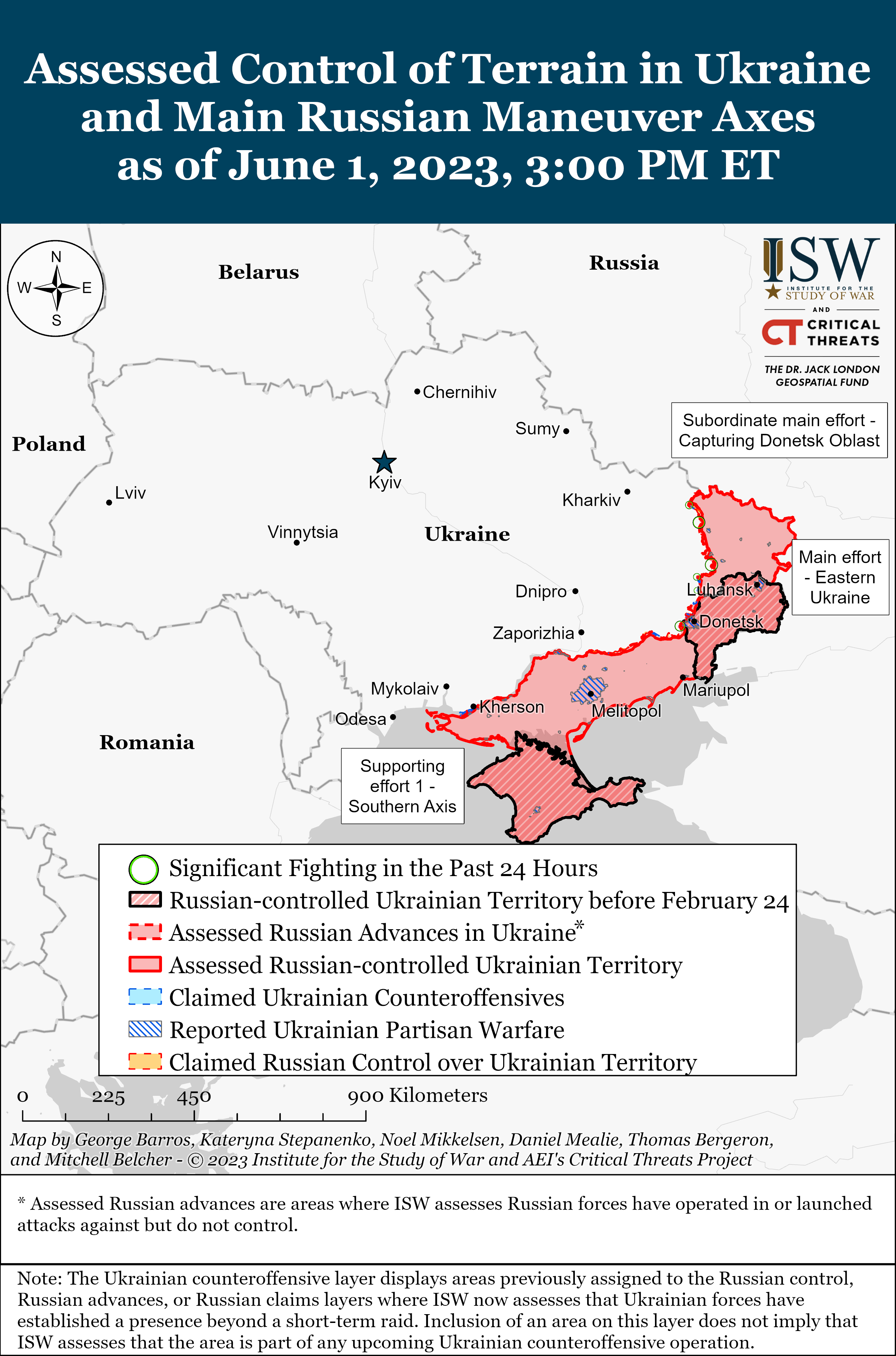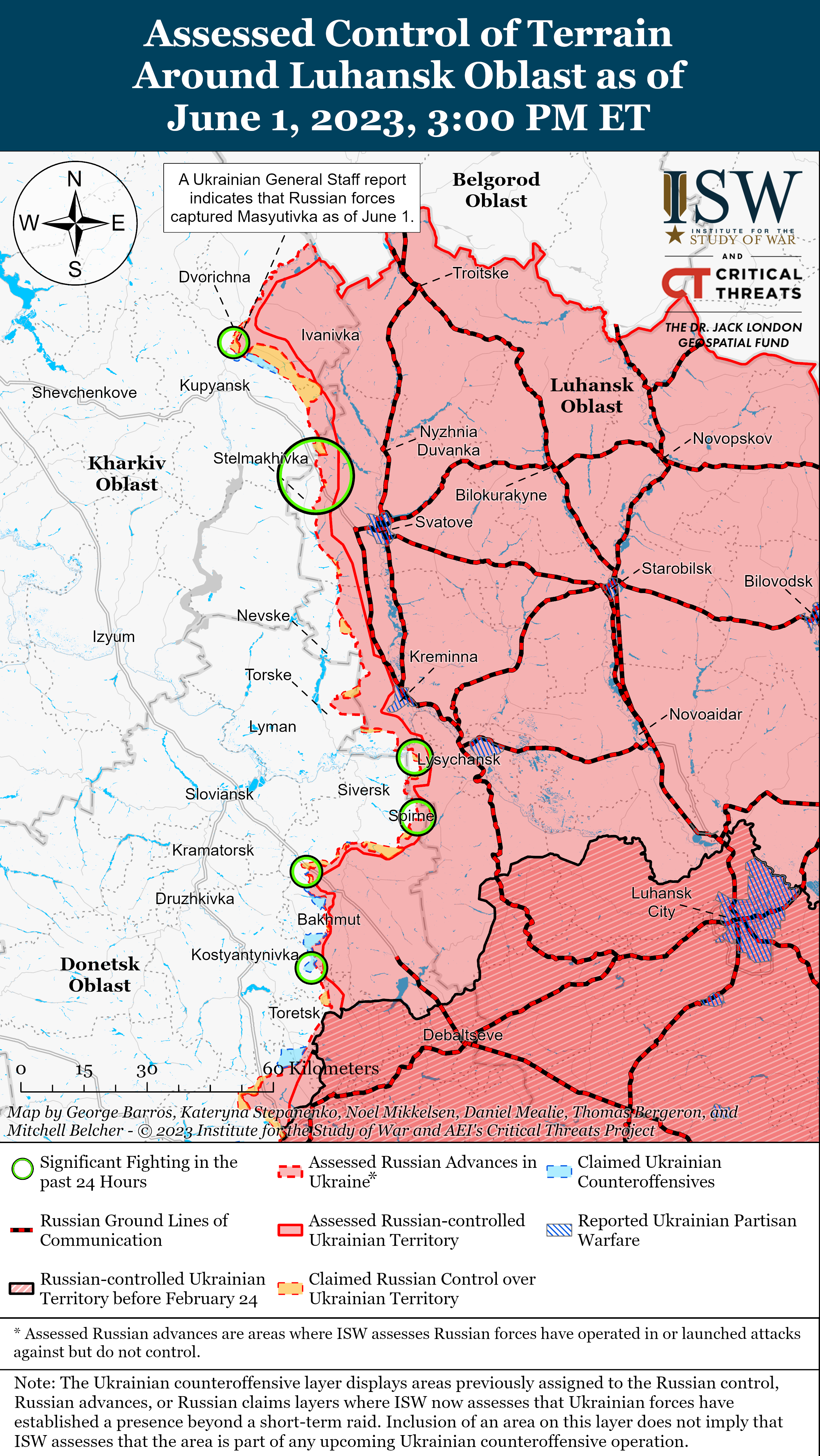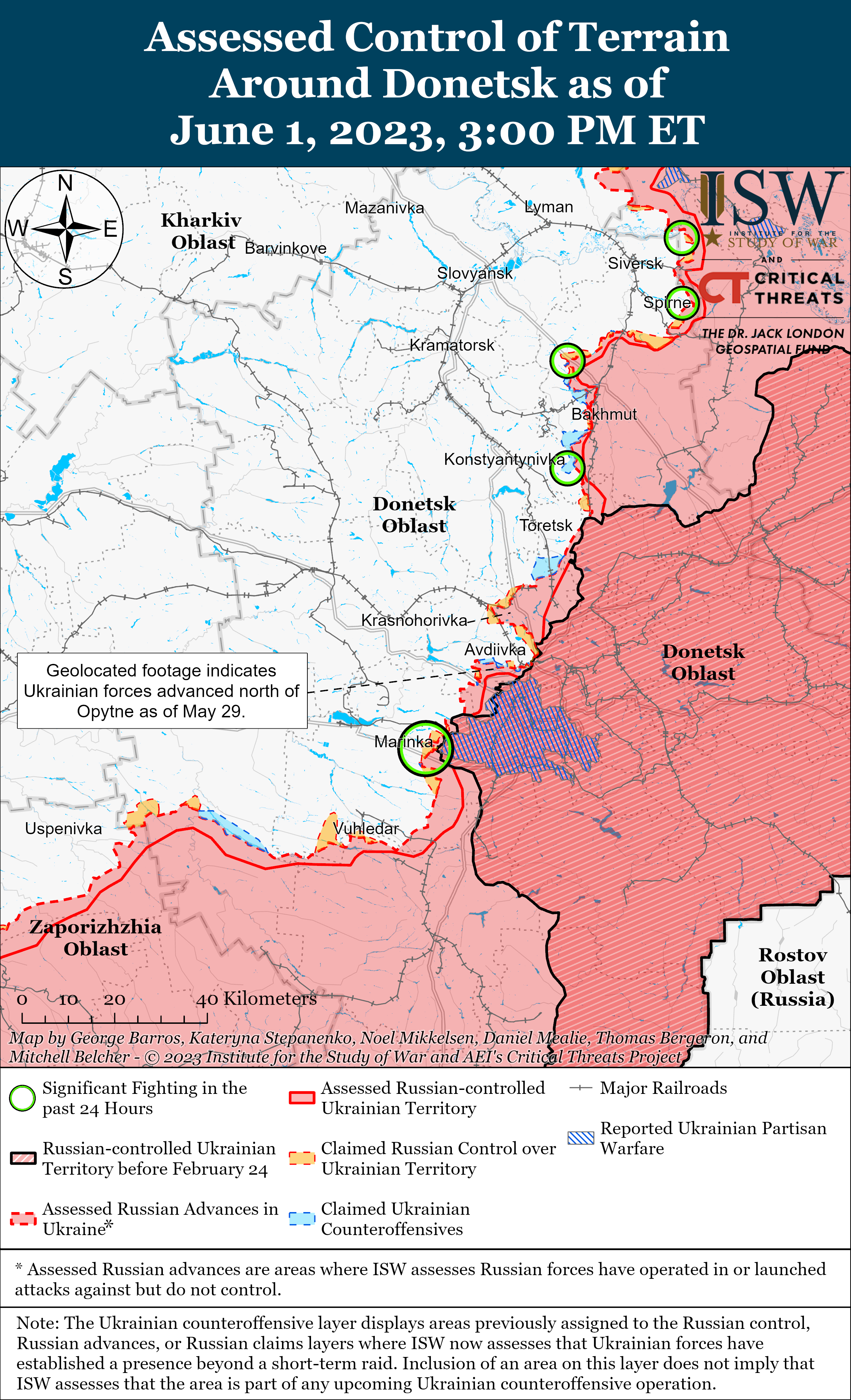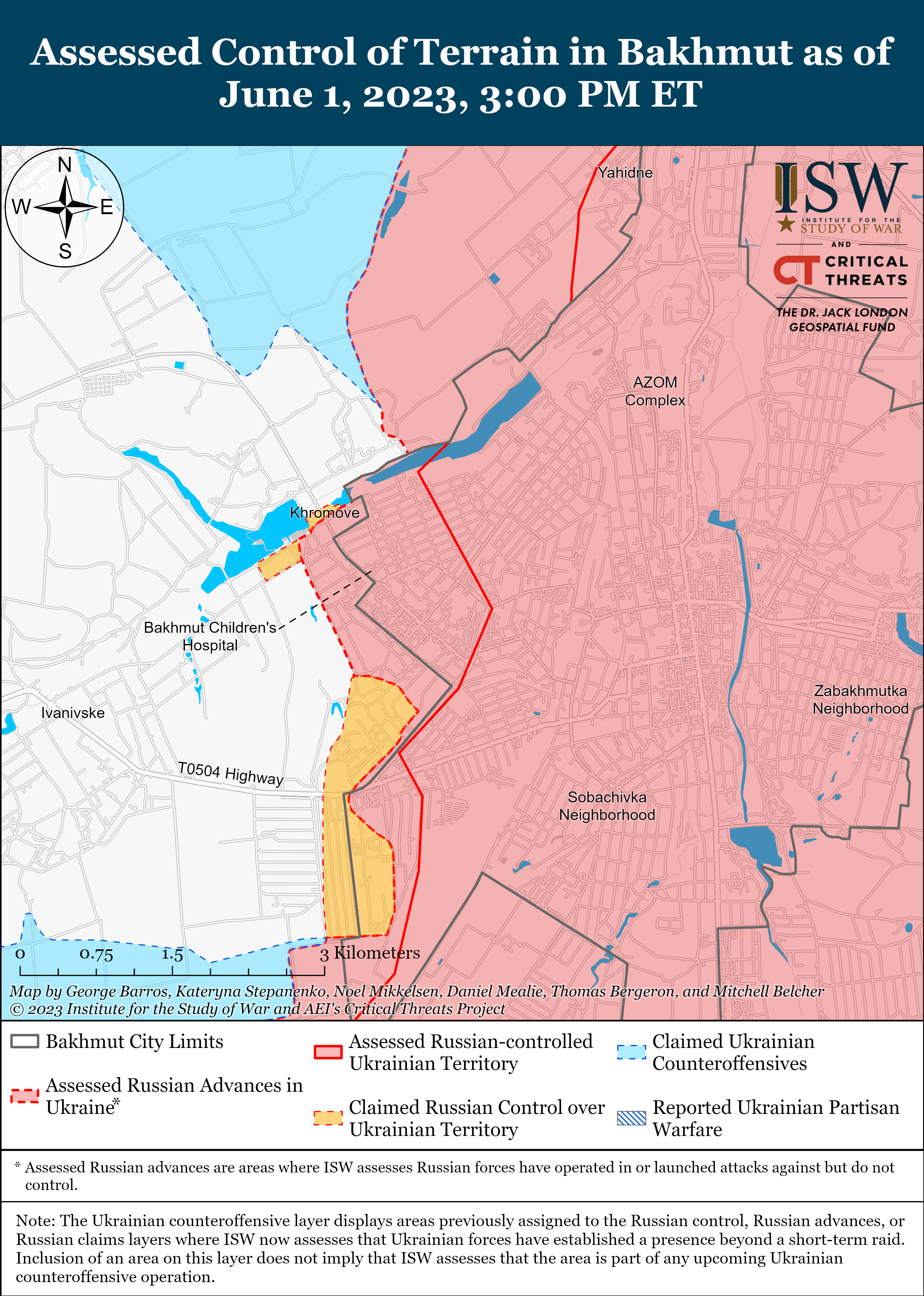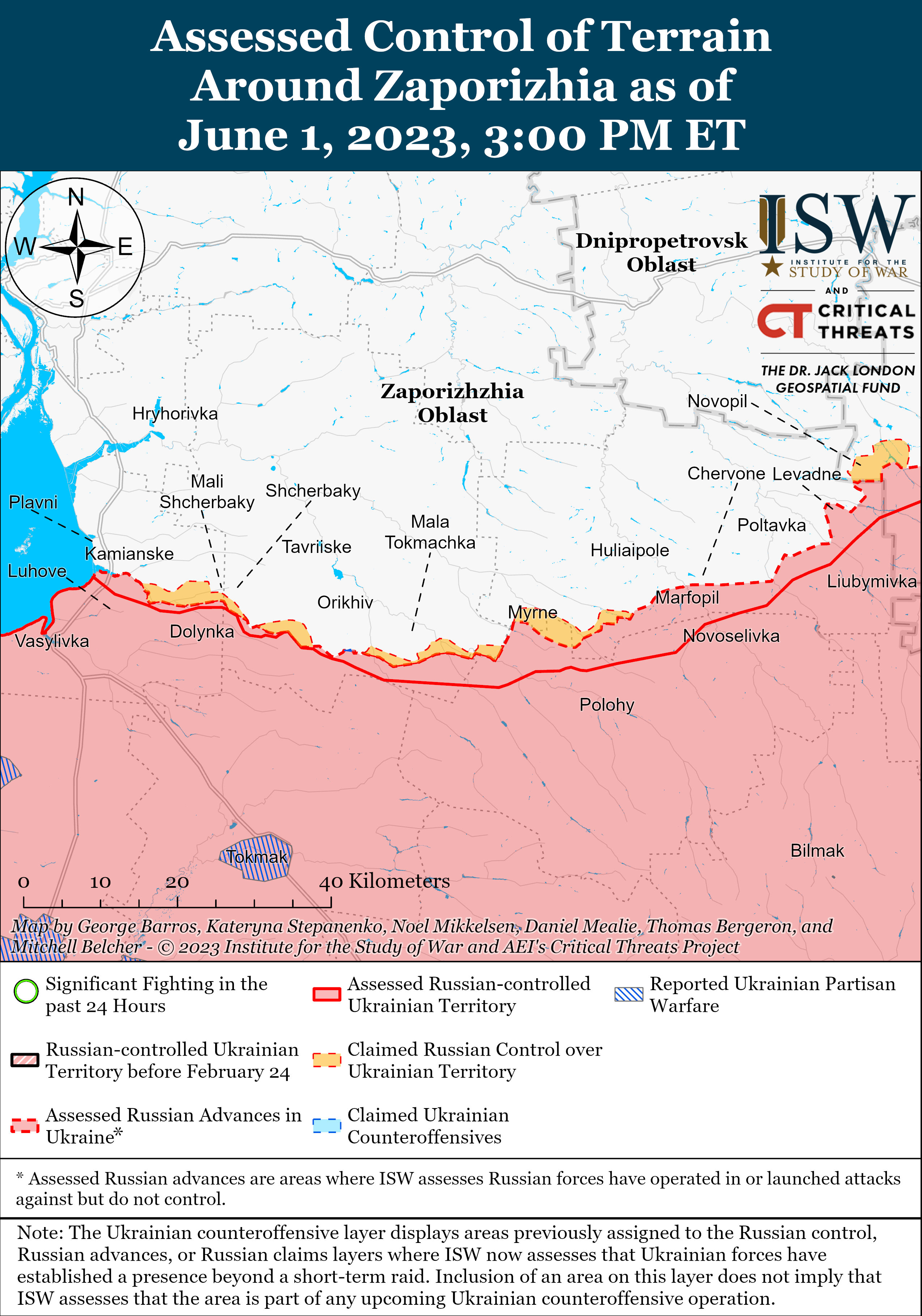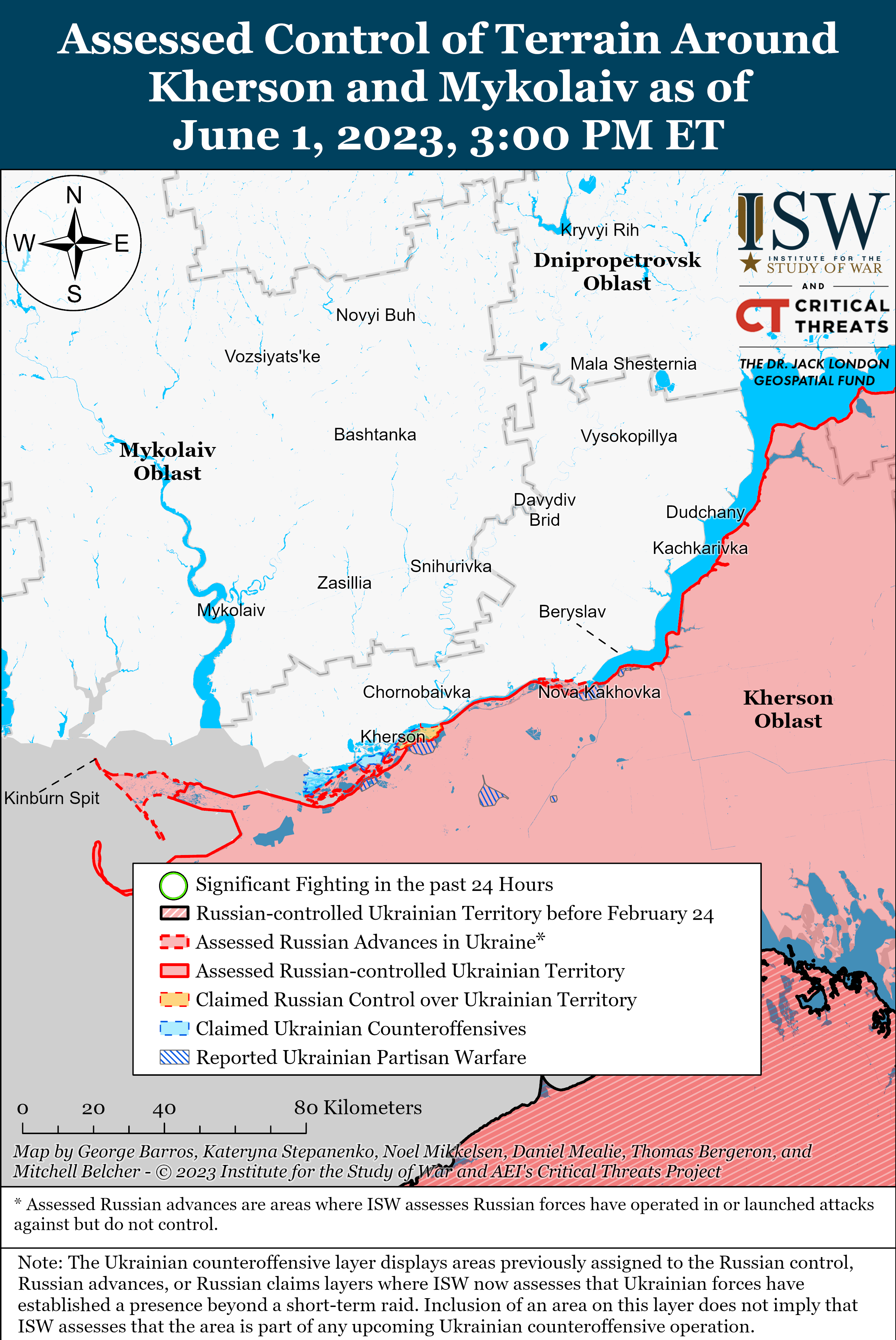Riley Bailey, Kateryna Stepanenko, Nicole Wolkov, Layne Philipson, George Barros, and Fredrick W. Kagan
June 1, 2023, 5:30pm ET
Click here to see ISW’s interactive map of the Russian invasion of Ukraine. This map is updated daily alongside the static maps present in this report.
Click here to access ISW’s archive of interactive time-lapse maps of the Russian invasion of Ukraine. These maps complement the static control-of-terrain map that ISW produces daily by showing a dynamic frontline. ISW will update this time-lapse map archive monthly.
Note: The data cutoff for this product was 1:30pm ET on June 1. ISW will cover subsequent reports in the June 2 Russian Offensive Campaign Assessment.
Russian forces conducted another series of missile strikes on Ukraine overnight on May 31 to June 1 and during the day on June 1. The Ukrainian General Staff reported that Russian forces launched 10 Iskander ballistic missiles targeting Kyiv City from Bryansk Oblast, which borders Ukraine, in the morning on June 1, and that Ukrainian air defense destroyed all 10 missiles.[1] The Ukrainian General Staff also reported that Russian forces launched two S-300 missiles targeting critical infrastructure in Kharkiv City during the day on June 1.[2] Ukrainian Air Force Spokesperson Colonel Yuriy Ihnat stated that Ukraine cannot strike launch points of Russian Iskander missiles in Russia as Ukraine is under obligations not to strike Russian territory with Western-provided weapons.[3] ISW has previously assessed that Russian forces began a new limited air campaign in recent months to degrade Ukrainian counteroffensive capabilities, but that the Russian prioritization of Kyiv is likely further limiting the campaign’s ability to meaningfully constrain potential Ukrainian counteroffensive actions.[4]
Elements of the all-Russian pro-Ukrainian Russian Volunteer Corps (RDK) and Freedom of Russia Legion (LSR) reportedly conducted another raid into Belgorod Oblast on June 1. Geolocated footage published on June 1 shows alleged LSR personnel operating near Novaya Tavolzhanka (3.5km from the Russian-Ukrainian border) and LSR and RDK personnel striking Russian positions near the settlement as well as Shebekino, Belgorod Oblast (7km from the Russian-Ukrainian border).[5] The RDK stated that the ”second phase” of its operations has begun and published footage purporting to show RDK personnel engaging in combat on the outskirts of Shebekino.[6] The Russian Ministry of Defense (MoD) claimed that Russian Border Guard Service and Federal Security Service (FSB) officers thwarted two motorized infantry companies reinforced with tanks that attempted to ”invade” Russian territory near Shebekino and Novaya Tavolzhanka.[7] Belgorod Oblast Governor Vyacheslav Gladkov stated that ”there were no enemies on the territory of Belgorod Oblast” during the attempted raids, although geolocated footage shows alleged LSR personnel operating on Russian territory.[8]
A prominent Russian milblogger claimed that 20 Russian border guards and 20 conscripts as well as Russian aviation and artillery units repelled the RDK and LRS personnel that attempted to conduct a raid near Shebekino.[9] Other Russian milbloggers claimed that the formations that conducted the raids near Shebekino and Novaya Tavolzhanka were roughly the size of a company and had tanks as well as other armored fighting vehicles, although one prominent milblogger claimed that the group that tried to enter near the Shebekino checkpoint was only comprised of 10 people.[10] The reported company size elements conducting these operations indicate that these operations in Belgorod Oblast are doctrinally raids. Raids, according to US Army doctrine, are small scale assault operations involving swift entry into hostile territory to secure information, disrupt hostile forces, or destroy installations.[11] Raids end with a planned withdrawal from a narrowly defined target area and do not seek to establish long-term control over territory. The RDK and LRS have not seriously attempted to control territory in Belgorod Oblast, either on June 1 or during their May 22 raid, despite their avowed goal to capture Russian territory.[12]
Russian officials and milbloggers’ responses to the limited raid in Belgorod Oblast are indicative of a continued heightened anxiety within the Russian information space regarding the war in Ukraine. Kremlin Spokesperson Dmitry Peskov stated on June 1 that Russian President Vladimir Putin constantly receives information about the situation in Belgorod Oblast, and that Putin awarded Shebekinsky Raion Head Vladimir Zhdanov the Order of Courage for his response to the situation along the border.[13] Gladkov announced that Russian officials in Belgorod Oblast evacuated 200 children to Penza Oblast and plan to evacuate another 600 children to Kaluga and Yaroslavl oblasts on June 3.[14] BBC’s Russia Service reported on June 1 that Gladkov agreed with authorities of several Russian regions to accept 1,200 Belgorod residents during evacuations.[15] These evacuations, Putin’s reported attentiveness, and the MoD’s characterization of the raid as an attempt to ”invade” Russian territory suggests that the Kremlin is trying to use these limited raids to support ongoing information operations that seek to portray the war in Ukraine as existential and garner domestic support for a protracted war.[16]
Select Russian milbloggers used the situation in Belgorod Oblast to criticize the Russian leadership while others argued that the limited raids are precursors for Ukrainian counteroffensive operations. Former Russian officer and ardent nationalist Igor Girkin argued that increased activity within Russia is a result of Russian forces wasting reserves in the fall of 2022, Russian officials failing to transition the economy to a war footing, and the Kremlin’s decision not to introduce martial law.[17] Girkin argued that these failures caused Ukraine to understand Russia’s relative weaknesses and suggested that they emboldened Ukrainian forces to conduct operations within Russia itself.[18] Girkin also argued that the Kremlin will likely respond to the alleged Ukrainian operations within Russia too late and that the Russian public’s support for the Russian leadership will wane by then.[19] Another milblogger criticized Putin directly for pretending that everything is fine in Shebekino.[20] Other milbloggers argued that the raids in Belgorod Oblast are a Ukrainian effort to divert Russian forces away from important sectors of the front in Ukraine to border regions ahead of potential Ukrainian counteroffensive operations.[21]
Chechen commanders and officials launched a concerted attack on Wagner Group financier Yevgeny Prigozhin on June 1 in a likely attempt to undermine Prigozhin. Chechen member of the Russian State Duma Adam Delimkhanov responded to Prigozhin’s May 31 statement in which Prigozhin noted that he is unaware Chechen units’ new positions in Ukraine and that Chechen forces will fight for select settlements, rather than the entirety of the Donetsk Oblast.[22] Prigozhin’s original statement appeared relatively neutral compared with his more inflammatory statements and did not directly criticize Chechen leader Ramzan Kadyrov or his forces. Delimkhanov informally addressed Prigozhin as “Zhenya” (a nickname for Yevgeny) and urged him to select a date on which they could meet to clarify what Chechen ”Akhmat” forces are doing on the frontlines.[23] Delimkhanov also called on Prigozhin to stop ”screaming” about Wagner’s shortages of military supplies and exposing Russian military failures to the world, and claimed that Prigozhin had already established himself as a “blogger” who is triggering Russian society to question his military capabilities. Delimkhanov stated that Wagner received more military equipment “than anyone else” from the Russian Ministry of Defense (MoD) and still suffered significant casualties.
Akhmat Special Forces (Spetsnaz) Commander Major General Apty Alaudinov echoed Delimkhanov’s statements, noting that he only respected Wagner personnel and not Prigozhin, despite Kadyrov’s personal fondness for Prigozhin.[24] Alaudinov stated that Wagner received tanks, planes, helicopters, and a 50,000-person army that the Akhmat forces did not receive. Alaudinov reiterated that Akhmat Spetsnaz is part of the Russian MoD and claimed that many former Wagner fighter had joined the Chechen armed formation. Chairman of the Chechen Parliament Magomed Daudov said that Prigozhin does not need to know the details of Chechen operations and stated that Prigozhin would have been killed for his critiques of the Russian military during World War II.[25] Daudov also indirectly implied that Kadyrov and Putin are the ones making decisions while Prigozhin overestimated his powers by trying to establish himself as the face of the war.[26]
Prigozhin responded to the attacks claiming that he will continue to voice his opinions until the Russian MoD officials are punished for their mistakes in planning the invasion of Ukraine.”[27] Prigozhin stated that his statements were not “reprehensible” and attached two videos from his latest press conference to eliminate “ambiguity” surrounding his claims. In one video, Prigozhin stated that the Russian security forces will “die instead of convicts” on the frontlines when responding to a question about Kadyrov’s proposal to send qualified security forces to fight in Ukraine. Prigozhin added that “nothing bad will happen” if half of the security forces leave to fight in the war.[28] The other video showed Prigozhin agreeing with Kadyrov’s proposal to declare martial law across Russia and stating that Russia will not finish the war in 2023.[29] Prigozhin also amplified a response from an unnamed Wagner commander to Daudov, who stated that Wagner is the best private military company (PMC) in the world and that Wagner had never received military supplies from Chechnya.[30] The Wagner commander also claimed that the Wagner forces perceived Daudov’s attack as a personal slight and questioned Daudov’s audacity in referring to Prigozhin as “Zhenya.”
Chechen attacks on Prigozhin’s character may be a part of the Kremlin’s efforts to discredit and undermine Prigozhin as his forces withdraw from the frontlines. The attacks notably occurred on June 1, which is both the day Prigozhin claimed Wagner would withdraw from the frontlines and his birthday. Prigozhin had previously complained that Russian state media outlets are banning mention of Prigozhin and Wagner forces.[31] Prigozhin may be finding himself in a more vulnerable position than when the Kremlin relied on his forces to capture Bakhmut, and has likely been attempting to remain relevant in the information space by conducting press conferences across Russia.[32] Igor Girkin speculated that Kadyrov has likely calculated the value in maintaining Prigozhin as an ally and concluded that Prigozhin cannot offer him any significant benefits.[33] Girkin also speculated that Kadyrov is not interested in a total collapse of the current military and political system that benefits him and his army, and so is distancing himself from Prigozhin who is attacking it.
Key Takeaways
- Russian forces conducted another series of missile strikes on Ukraine overnight on May 31 to June 1 and during the day on June 1.
- Elements of the all-Russian pro-Ukrainian Russian Volunteer Corps (RDK) and Freedom of Russia Legion (LSR) reportedly conducted another raid into Belgorod Oblast on June 1.
- Russian officials and milbloggers’ responses to the limited raid in Belgorod Oblast are indicative of a continued heightened anxiety within the Russian information space regarding the war in Ukraine.
- Chechen commanders and officials launched a concerted attack on Wagner Group financier Yevgeny Prigozhin on June 1 in a likely attempt to undermine Prigozhin’s appeal.
- Prigozhin responded to the attacks claiming that he will continue to voice his opinions until Russian MoD officials are punished for their mistakes in planning the invasion of Ukraine
- Chechen attacks on Prigozhin’s character may be a part of the Kremlin’s efforts to discredit and undermine Prigozhin as his forces withdraw from the frontlines.
- Russian forces conducted offensive operations northeast of Kupyansk and northwest of Svatove.
- The tempo of Russian and Ukrainian offensive operations in the Bakhmut direction remains low as of June 1, and Russian forces conducted limited ground attacks along the Avdiivka-Donetsk City line.
- Russian forces did not conduct any confirmed ground attacks along the southern axis.
- The Russian State Duma rejected a draft law that would have granted mobilization exemptions to candidates and doctors of the science.
- Russian occupation authorities announced that regional elections in occupied territories will take place on September 10.
- Ukrainian Prosecutor General Andriy Kostin announced on May 31 that Ukraine is investigating over 2,900 crimes against children committed by Russian forces.
We do not report in detail on Russian war crimes because these activities are well-covered in Western media and do not directly affect the military operations we are assessing and forecasting. We will continue to evaluate and report on the effects of these criminal activities on the Ukrainian military and the Ukrainian population and specifically on combat in Ukrainian urban areas. We utterly condemn these Russian violations of the laws of armed conflict, Geneva Conventions, and humanity even though we do not describe them in these reports.
- Russian Main Effort – Eastern Ukraine (comprised of two subordinate main efforts)
- Russian Subordinate Main Effort #1 – Capture the remainder of Luhansk Oblast and push westward into eastern Kharkiv Oblast and encircle northern Donetsk Oblast
- Russian Subordinate Main Effort #2 – Capture the entirety of Donetsk Oblast
- Russian Supporting Effort – Southern Axis
- Russian Mobilization and Force Generation Efforts
- Activities in Russian-occupied areas
Russian Main Effort – Eastern Ukraine
Russian Subordinate Main Effort #1 – Luhansk Oblast (Russian objective: Capture the remainder of Luhansk Oblast and push westward into eastern Kharkiv Oblast and northern Donetsk Oblast)
Russian forces continued offensive operations on the Svatove-Kupyansk line on June 1. The Ukrainian General Staff reported that Ukrainian forces repelled Russian attacks west of Masyutivka (13km northeast of Kupyansk) and in the direction of Stelmakhivka (15km northwest of Svatove).[34] The Ukrainian General Staff’s mention of attacks west of Masyutivka likely indicates that Russian forces captured the settlement on an unspecified earlier date. Russian sources claimed that Russian forces captured Masyutivka as early as May 15.[35] Geolocated footage published on May 31 indicates that Russian forces made marginal gains southeast of Masyutivka.[36] Russian Western Group of Forces (Western Military District) Spokesperson Sergei Zybinsky claimed that unspecified elements of the 6th Combined Arms Army of the Western Military District repelled two Ukrainian attacks near Movchanove (10km northeast of Kupyansk) railway station.[37] A Russian milblogger claimed that fighting is ongoing near Masyutivka, Synkivka (9km northeast of Kupyansk) and Dvorichna (17km northeast of Kupyansk), and that Russian forces are continuing to expand control over areas in the vicinity of Masyutivka.[38]
Russian forces continued limited offensive operations near Kreminna on June 1. A Russian news aggregator claimed that Russian airborne forces (VDV) advanced two kilometers near Kreminna.[39] The Ukrainian General Staff reported that Russian forces conducted unsuccessful offensive operations near Bilohorivka (11km south of Kreminna) and Spirne (26km south of Kreminna).[40] The Russian MoD claimed that the Russian forces repelled a Ukrainian sabotage and reconnaissance group near Kreminna.[41]
Russian Subordinate Main Effort #2 – Donetsk Oblast (Russian Objective: Capture the entirety of Donetsk Oblast, the claimed territory of Russia’s proxies in Donbas)
Click here to read ISW’s retrospective analysis on the Battle for Bakhmut.
The tempo of Russian and Ukrainian offensive operations in the Bakhmut area remains low as of June 1. The Ukrainian General Staff reported that Russian forces conducted unsuccessful offensive operations near Orikhovo-Vasylivka (11km northeast of Bakhmut) and Bila Hora (12km southwest of Bakhmut).[42] A Russian milblogger claimed that Russian forces repelled Ukrainian forces near the Berkhivske reservoir (4km northwest of Bakhmut).[43] Ukrainian Ground Forces Commander Colonel General Oleksandr Syrskyi reported that Russian forces have transitioned to the defensive, decreased active operations, and increased artillery fire.[44] Ukrainian Deputy Defense Minister Hanna Malyar reported on May 31 that Ukrainian forces maintain control over the southwestern outskirts and entrance to Bakhmut City.[45]
Wagner Group financier Yevgeny Prigozhin claimed that most Wagner personnel have left Bakhmut and that all personnel will leave by June 5. Prigozhin claimed that only about 90 Wagner personnel remain in Bakhmut and will leave by June 5.[46] Prigozhin claimed that Wagner forces will rest and train in rear areas of Luhansk and Donetsk oblasts for a month and emphasized that he wants Wagner forces to fight on a front where they can perform all tasks alone.[47]
Russian forces conducted limited ground attacks along the Avdiivka-Donetsk City line on June 1. The Ukrainian General Staff reported that Russian forces did not conduct offensive operations in the Avdiivka direction and that Ukrainian forces repelled all Russian attacks near Marinka.[48] A Russian milblogger claimed on June 1 that Russian forces made advances northeast of Avdiivka, although ISW has not observed visual confirmation supporting this claim.[49] Another milblogger claimed that Russian forces attempted to advance toward Sieverne (6km west of Avdiivka).[50] The Russian Ministry of Defense (MoD) claimed that elements of the 1st Donetsk People‘s Republic (DNR) Army Corps conducted offensive operations near Avdiivka, and that assault detachments of the 5th Motorized Rifle Brigade of the 1st Army Corps and Chechen “Akhmat” Special Forces (Spetsnaz) continued offensive operations in the Marinka direction.[51] A milblogger claimed that Russian forces conducted assault operations in the direction of Pobieda (5km southwest of Donetsk City) and Novomykhailivka (10km southwest of Donetsk City).[52] Footage amplified on May 31 purportedly shows the 10th Tank Regiment (3rd Army Corps, Western Military District) operating in the Avdiivka direction.[53]
Russian forces did not conduct any confirmed or claimed ground attacks in western Donetsk Oblast on June 1.[54]
Russian Supporting Effort – Southern Axis (Russian objective: Maintain frontline positions and secure rear areas against Ukrainian strikes)
Russian forces did not conduct any confirmed ground attacks along the southern axis on June 1. The Ukrainian General Staff and Ukraine’s Southern Operational Command reported that Russian forces are conducting defensive operations in the southern operational direction in Kherson and Zaporizhia oblasts.[55] Russian forces continued to conduct regular indirect fire against Ukrainian-held settlements across the southern frontline.[56] Footage posted on May 31 shows reported elements of the Russian 127th Guards Motorized Rifle Division (5th Combined Arms Army, Eastern Military District) conducting artillery fire against Ukrainian positions in Novopil, Donetsk Oblast (30km east of Hulyaipole).[57]
A Ukrainian military official discussed Ukrainian artillery strikes along the southern axis on June 1. Ukrainian Tavria Defense Force Grouping Commander Brigadier General Oleksandr Tarnavskyi stated on June 1 that Ukrainian artillery elements conducted 832 fire missions in the Tavriisk direction (Zaporizhia and Kherson oblasts) in the last 24 hours.[58] Zaporizhia Oblast occupation official Vladimir Rogov and a prominent Kremlin-aligned milblogger reported on June 1 that Ukrainian artillery and helicopter activity noticeably intensified in Zaporizhia Oblast over the past 24 hours.[59]
Ukrainian forces continue to operate on the Dnipro River delta’s islands. Geolocated combat footage posted on June 1 shows Russian artillery strikes against Ukrainian forces – likely reconnaissance elements – on the northwestern part of Velykyi Potemkin Island.[60]
Russian Mobilization and Force Generation Efforts (Russian objective: Expand combat power without conducting general mobilization)
The Russian State Duma rejected a draft law that would have granted mobilization exemptions to PhD candidates and those with science doctorates.[61] State Duma Deputy Mikhail Matveev published a review of the draft law on May 31 and argued that there is no concept of “partial” mobilization in the law and that the Russian MoD should not limit itself for future mobilization efforts.[62] ISW has previously assessed that Russian officials may be prioritizing immediate force generation requirements over long-term human capital needs.[63]
Russian sources claimed on June 1 that the volunteer project “Swarm VOZmedia” delivered thousands of commercially available dual use combat drones to Russian units that are a part of the Southern Grouping of forces (Southern Military District).[64]
Public schools in several Russian regions are reportedly creating programs for schoolchildren to learn how to assemble and operate drones. Independent Russian investigative outlet Vazhnye Istorii (iStories) reported on June 1 that Russian officials in St. Petersburg have allocated 1 million rubles to buy 15 training drones and to start educational programs in St. Petersburg schools.[65] iStories reported that Russian officials in Sakha Republic and Kaliningrad and Sakhalin oblasts have also purchased training drones to start programs for schoolchildren.[66] Prominent Russian milbloggers have previously advocated for schools to offer educational drone programs to support long term drone production and training efforts, and Russian president Vladimir Putin stated on April 28 that he fully supports such measures.[67]
Activities in Russian-occupied areas (Russian objective: Consolidate administrative control of annexed areas; forcibly integrate Ukrainian civilians into Russian sociocultural, economic, military, and governance systems)
Russian President Vladimir Putin announced an order on May 31 requiring medical examinations for adults in occupied territories after claiming that mandated medical examinations of children were “quite organized and produced good results.”[68] Russian officials and occupation authorities may use mandated medical examinations of adults to augment future force generation in occupied territories by establishing who is and who is not fit for military service. The Russian MoD may also use these examinations to expedite future force generation efforts in occupied territories to determine individuals who are fit to serve.
Ukrainian Prosecutor General Andriy Kostin announced on May 31 that Ukraine is investigating over 2,900 crimes against children committed by Russian forces.[69] Kostin stated that Ukraine has registered 19,400 cases of illegal deportations of Ukrainian children, noting that the figure is likely much higher as Ukraine has almost certainly not recorded all cases.[70] Kostin stated that 483 Ukrainian children have been killed and 989 wounded as a result of Russia’s illegal invasion of Ukraine.[71]
Russian officials and occupation authorities continue to use infrastructure projects to integrate occupied territories into Russia. Kherson Oblast Occupation Administration Head Vladimir Saldo stated that he met with Russian Minister of Energy Nikolai Shulginov to discuss adjusting the regional energy system since energy flows now come from Crimea rather than Ukrainian-controlled territory. Shulginov claimed that builders have already reconstructed approximately 250 electric power supply facilities and 26 gas grids throughout occupied Kherson Oblast.[72] Donetsk People’s Republic (DNR) Head Denis Pushilin announced on June 1 that his administration and the Russian Federal Road Agency (Rosavtodor) signed a five-year agreement on developing roads in occupied Donetsk Oblast aimed at strengthening north-south and east-west transportation and developing road infrastructure in the Azov-Black Sea Basin.[73]
Russian occupation authorities announced that regional elections in occupied territories will take place on September 10.[74] Luhansk People’s Republic (LNR) head Leonid Pasechnik stated on May 31 that United Russia General Council Secretary Andrei Turchak invited him and the heads of other occupied territories to head the list of candidates for the regional elections.[75] Turchak claimed that 466,000 residents of occupied territories participated in preliminary voting, noting that 209,000 voters reside in occupied Donetsk Oblast.[76]
Significant activity in Belarus (ISW assesses that a Russian or Belarusian attack into northern Ukraine is extraordinarily unlikely).
ISW will continue to report daily observed Russian and Belarusian military activity in Belarus, but these are not indicators that Russian and Belarusian forces are preparing for an imminent attack on Ukraine from Belarus. ISW will revise this text and its assessment if it observes any unambiguous indicators that Russia or Belarus is preparing to attack northern Ukraine.
Belarusian authorities continue developing infrastructure to support Russian-provided and likely Russian-controlled air defense systems in Belarus. Satellite imagery captured on May 20 and published on June 1 shows construction activity progress at the Pribytki Air Base in Belarus (16 km southeast of Gomel City).[77] Analysis of the imagery indicates this base received another 40V6MR Radar mast and an additional twin missile reload pack for the S-300 air defense system.[78]
Note: ISW does not receive any classified material from any source, uses only publicly available information, and draws extensively on Russian, Ukrainian, and Western reporting and social media as well as commercially available satellite imagery and other geospatial data as the basis for these reports. References to all sources used are provided in the endnotes of each update.
[3] https://www.ukrinform dot ua/rubric-ato/3716929-ukraina-ne-zavdavatime-udariv-po-punktah-dislokacii-iskanderiv-u-rf-ignat.html
[4] https://www.understandingwar.org/backgrounder/russian-offensive-campaign... https://isw.pub/UkrWar051423; https://understandingwar.org/backgrounder/russian-offensive-campaign-ass...
[5] https://t.me/legionoffreedom/833; https://twitter.com/COUPSURE/status/1664230361155469315; https://twitter.com/GeoConfirmed/status/1664236922204569601?s=20; https://twitter.com/zcjbrooker/status/1664207383378243585; https://twitter.com/antiputler_news/status/1664199742438424576 ; https://twitter.com/bayraktar_1love/status/1664184875505598467?s=20; https://t.me/severrealii/17168; https://t.me/astrapress/28445; https://twitter.com/GeoConfirmed/status/1664195588064260096?s=20; https://twitter.com/bayraktar_1love/status/1664189434261110789?s=20; https://twitter.com/M160831M/status/1664190107048443905?s=20; https://t.me/legionoffreedom/828 ;
[6] https://t.me/russvolcorps/573 ; https://twitter.com/Militarylandnet/status/1664227217113579520?s=20 ; https://t.me/russvolcorps/561
[8] https://twitter.com/zcjbrooker/status/1664207383378243585; https://twitter.com/antiputler_news/status/1664199742438424576
[10] https://t.me/sashakots/40021 ; https://t.me/vysokygovorit/11807; https://t.me/vysokygovorit/11806; https://t.me/vysokygovorit/11804; https://t.me/vysokygovorit/11803
[11] https://www.moore.army.mil/Infantry/DoctrineSupplement/ATP3-21.8/chapter_04/section_06/page_0100/index.html
[12] https://www.understandingwar.org/backgrounder/russian-offensive-campaign-assessment-may-22-2023 ; https://twitter.com/Gerashchenko_en/status/1664161977130729473; https://t.me/istories_media/2623; https://t.me/astrapress/28418; https://t.me/astrapress/28419 ; https://t.me/russvolcorps/561
[13] https://tass dot ru/politika/17903091 ; https://tass dot ru/politika/17907787
[25] https://news.yahoo.com/chechen-warmongers-threaten-showdown-prigozhin-144259582.html?guccounter=1&guce_referrer=aHR0cHM6Ly93d3cuZ29vZ2xlLmNvbS8&guce_referrer_sig=AQAAABp0nvwojuTVuRvap129Ed-6DEKxMGKPLZflHbKn35TCGeGrCuI-K6b-IWCqE4PGcAOAXmkSGTCnUW7DF2xVwdBRMB0PLlLgAgehQMEls6otDSKK7AfaGfrxkvZX42d8vOqakQRkZfT-JPfKQwJu022wbn_nG86g5_ePDrJk4sl9
[26] https://news.yahoo.com/chechen-warmongers-threaten-showdown-prigozhin-144259582.html?guccounter=1&guce_referrer=aHR0cHM6Ly93d3cuZ29vZ2xlLmNvbS8&guce_referrer_sig=AQAAABp0nvwojuTVuRvap129Ed-6DEKxMGKPLZflHbKn35TCGeGrCuI-K6b-IWCqE4PGcAOAXmkSGTCnUW7DF2xVwdBRMB0PLlLgAgehQMEls6otDSKK7AfaGfrxkvZX42d8vOqakQRkZfT-JPfKQwJu022wbn_nG86g5_ePDrJk4sl9
[30] https://t.me/concordgroup_official/1114; https://t.me/razgruzka_vagnera/135 ; https://t.me/razgruzka_vagnera/136
[31] https://www.understandingwar.org/backgrounder/russian-offensive-campaign-assessment-may-28-2023
[34] https://www.facebook.com/GeneralStaff.ua/posts/pfbid02i2CAhddg4GH4475S1LTXxNsApMxnKRAaTPHiqd3T7KVV7bGFUU8MRQdbXVHHj4Fjl; https://www.facebook.com/GeneralStaff.ua/posts/pfbid0g2Kdab7rekpwT46H3FHZrQPPnyE89vapCFaXFrSM7bMuk87cQHkLgYuqFpDrtSX4l
[36] https://twitter.com/PuenteUribarri/status/1663909775283826698?s=20 ; https://twitter.com/klinger66/status/1664062021782962179?s=20
[40] https://www.facebook.com/GeneralStaff.ua/posts/pfbid0g2Kdab7rekpwT46H3FHZrQPPnyE89vapCFaXFrSM7bMuk87cQHkLgYuqFpDrtSX4l; https://www.facebook.com/GeneralStaff.ua/posts/pfbid02i2CAhddg4GH4475S1LTXxNsApMxnKRAaTPHiqd3T7KVV7bGFUU8MRQdbXVHHj4Fjl
[48] https://www.facebook.com/GeneralStaff.ua/posts/pfbid0g2Kdab7rekpwT46H3FHZrQPPnyE89vapCFaXFrSM7bMuk87cQHkLgYuqFpDrtSX4l; https://www.facebook.com/GeneralStaff.ua/posts/pfbid02i2CAhddg4GH4475S1LTXxNsApMxnKRAaTPHiqd3T7KVV7bGFUU8MRQdbXVHHj4Fjl
[54] https://www.facebook.com/GeneralStaff.ua/posts/pfbid0g2Kdab7rekpwT46H3FHZrQPPnyE89vapCFaXFrSM7bMuk87cQHkLgYuqFpDrtSX4l; https://www.facebook.com/GeneralStaff.ua/posts/pfbid02i2CAhddg4GH4475S1LTXxNsApMxnKRAaTPHiqd3T7KVV7bGFUU8MRQdbXVHHj4Fjl
[55] https://www.facebook.com/OperationalCommandSouth/posts/pfbid02QWya9dcjw9jrqCBGLYQK8gnMVEA7RY5aBtzPQyM4AspyjFtejdJc5K2uRyGdYFPE; https://www.facebook.com/GeneralStaff.ua/posts/pfbid02i2CAhddg4GH4475S1LTXxNsApMxnKRAaTPHiqd3T7KVV7bGFUU8MRQdbXVHHj4Fjl; https://www.facebook.com/GeneralStaff.ua/posts/pfbid0g2Kdab7rekpwT46H3FH...
[56] https://www.facebook.com/OperationalCommandSouth/posts/pfbid02QWya9dcjw9... https://www.facebook.com/GeneralStaff.ua/posts/pfbid02i2CAhddg4GH4475S1L... https://www.facebook.com/GeneralStaff.ua/posts/pfbid0g2Kdab7rekpwT46H3FHZrQPPnyE89vapCFaXFrSM7bMuk87cQHkLgYuqFpDrtSX4l; https://t.me/mod_russia/27018; https://t.me/zoda_gov_ua/19133
[57] https://twitter.com/PauliusZaleckas/status/1663933359389638656; https://t.me/Vmsd127/53; https://twitter.com/PauliusZaleckas/status/1663933361931296769
[59] https://t.me/wargonzo/12898; https://t.me/vrogov/9931; https://t.me/vrogov/9938; https://t.me/vrogov/9937; https://t.me/vrogov/9940
[60] https://twitter.com/zcjbrooker/status/1664223729402929152; https://t.me/Dnepro_Rub/263; https://twitter.com/zcjbrooker/status/1664223731269369856; https://twitter.com/GeoConfirmed/status/1664242592735789056?s=20
[63] https://www.understandingwar.org/backgrounder/russian-offensive-campaign-assessment-may-27-2023
[64] https://t.me/nm_dnr/10397 ; https://t.me/basurin_e/2346 ; https://t.me/NeoficialniyBeZsonoV/26018
[65] https://storage.googleapis dot com/istories/news/2023/06/01/rossiiskie-shkoli-nachali-zakupat-bespilotniki-dlya-obucheniya-detei/index.html
[66] https://storage.googleapis dot com/istories/news/2023/06/01/rossiiskie-shkoli-nachali-zakupat-bespilotniki-dlya-obucheniya-detei/index.html
[67] https://understandingwar.org/backgrounder/russian-offensive-campaign-assessment-april-28-2023 ;
[68] https://tass dot ru/obschestvo/17892413
[69] https://t.me/bbcrussian/47142; https://twitter.com/AndriyKostinUa/status/1663943824840835073?cxt=HHwWgo...
[70] https://t.me/bbcrussian/47142; https://twitter.com/AndriyKostinUa/status/1663943824840835073?cxt=HHwWgo...
[77] https://twitter.com/konrad_muzyka/status/1664178920587943937?s=20; https://rochanconsulting dot substack.com/p/satellite-imagery-analysis-pribytki-5fd
[78] https://twitter.com/konrad_muzyka/status/1664178920587943937?s=20; https://rochanconsulting dot substack.com/p/satellite-imagery-analysis-pribytki-5fd

